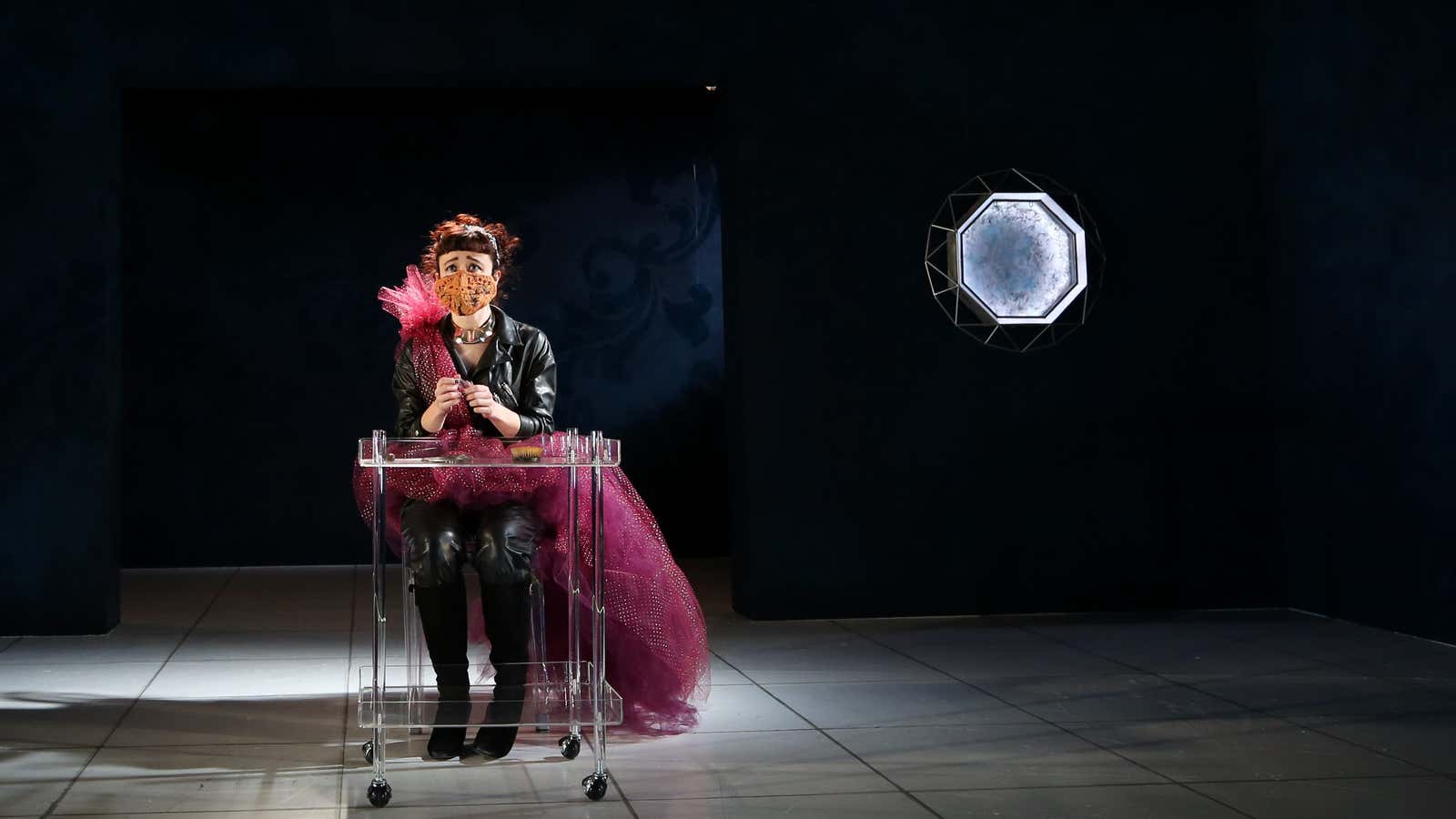Every play during a pandemic is, by necessity, experimental. For the few theater companies that are attempting to hold live performances, every artistic element of staging—from set design and casting to costumes—is being reconsidered to safeguard the health of actors, stage crew, and theater-goers.
This spirited, trial-and-error ethos courses through New York University’s theatrical production wing, which has been holding live performances since last October. For its latest production, a modern adaptation of William Shakespeare’s Romeo and Juliet, the cast of 15 actors are spread across two theaters, with live action supplemented with a live video feed of both stages. Audience members in both theaters are seated six feet apart and asked to show proof of a negative Covid-19 test before they’re allowed in the venue. Per the school’s guidelines, actors, crew members, and faculty are tested regularly, and are required to wear masks at all times.
“I think it’s impossible to predict what sitting in a theater will be like in a year or two from now because there are so many factors at play,” says Laurence Maslon, a theater scholar and associate chair of NYU’s graduate acting program. “The great thing about these experiments is that they’re making the best out of what’s within our control and honoring what’s not.”
So far, NYU’s is the only MFA program in the country that’s figured out how to safely hold shows for a live audience. It’s no small feat considering that most productions from Broadway to London’s West End remain shuttered. The Broadway League, the trade union for the US theater industry, predicts that some shows could reopen this May, but it has had to push back that date six times already. Some insiders say that theaters will likely remain dark until July 2022. According to a recent Brookings Institute report, this has cost the industry 1.4 million jobs and $42.5 billion in lost sales.

Masks take center stage
NYU’s costume department has played a crucial role in the avant-garde staging of Romeo and Juliet, tailoring Covid-compliant face masks that double as a storytelling device. The masks are used to identify actors who switch roles throughout the play.

Knowing the demands on actors during a performance, Krista Intranuovo and Lauren Carmen, both graduate students at the costume department, were concerned most about fit. With the guidance of Daun Fallon, NYU’s costume shop manager, they figured out that double-lined masks lined with a layer of gauze material work best for extended wear.
Theater actors, in many ways, offer an extreme use case for mask makers. With 12-hour tech rehearsals under hot stage lights, watching them prepare for a show can reveal vulnerabilities of many face mask designs in the market. “Many commercially-available face masks would be disastrous in performance, even if some of them look really great,” explains Constance Hoffman, head of costume design at the NYU Tisch design for stage and film department.
For instance, a face-flattering satin mask would prove to be disastrous in terms of breathability, Hoffman explains. Plastic shields that cover the entire face offering an extra layer of protection, but they tend to distort the actors’ voices and create a drum-like sound. Some actors lament that KN-95 masks are too stiff. And masks with plastic windows, while great for showing people’s mouths, also rate poorly in terms of breathability.
“The irony, I suppose, is that theater historically had always been done with masks,” explains Maslon, citing examples in Noh plays in Japan, in commedia dell’arte in Italy, and topeng masks traditional in Balinese performances. Of course, even the best-made masks pose limitations, especially in plots that involve physical contact among actors. “It’s important at some point that the male lead and the female lead to hug and kiss, for example,” says Maslon. “They’re full of love, so they can’t demonstrate that. [Without physical contact], the story tends to land by implication.” He adds that actors are instructed to be more gestural to better convey emotions through their PPE.
Ultimately, the costume department’s quest to improve on standard face masks serves as a vital lesson in design accessibility. “There’s so much uniqueness across the spectrum of human bodies,” explains Carmen. “There’s never going to be one thing that works for everyone.”
Live theater during the 1918 pandemic
Reimagining a theater production for a pandemic is new terrain. During the 1918 influenza pandemic, most playhouses in New York defiantly remained open, with the encouragement of then-health commissioner Royal Copeland. Defying the US surgeon general’s appeal, Copeland fought to keep theaters open to buoy spirits. “My aim was to prevent panic, hysteria, mental disturbance,” he explained to the New York Times. “[My aim was] to protect the public from the condition of mind that in itself predisposes to physical ills. I attempted to maintain the morale of New York City.”
In the era before TV, playhouses and movie theaters also served as places to disseminate public health information. Before each show, someone stood before the audience and explained the dangers of the deadly flu that had killed hundreds of thousands of Americans. Anyone sneezing or coughing was kicked out. In an effort to ease the congestion in Times Square, Copeland asked theaters to stagger their curtain times. Writing for American Theater, Charlotte M. Canning, director of the Oscar G. Brockett Center for Theater History and Criticism, explained that many cities risked keeping playhouses open:
Articles in papers in every state put the status of theaters in their communities on the front page above the fold. Page one of the Richmond, Va., News Leader on Oct. 5 announced that “Every Church, Every School Is Ordered Closed, Also Playhouses.” The three institutions were often grouped together—schools, churches, and theaters—as if they were a single category and of equal importance to the national community.
Theaters were so important that people did not lightly forgo attendance. Their closure remained a great public frustration, even as people were dying.
London’s theater district also remained open during the 1918 pandemic. Though actors got sick, British playhouses packed their venues with crowds seeking “serotonin-producing musicals,” explained theater critic Aleks Sierz in iNews. “In times of such stress, the best antidote is fun,” he says. “The hugely popular gaiety shows, first staged in Edwardian times, were revived. They involved pop songs, frenetic dancing and stories about initially improper but ultimately decent single women.”
It’s good that theaters today are being more cautious. But the deep desire people have to come together to put on and take in art hasn’t gone away. ”Honestly,” Intranuovo says, “it’s such a privilege to have the chance to do things in person, even in a restrictive way.”
